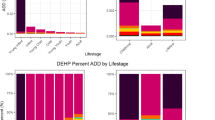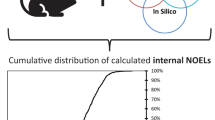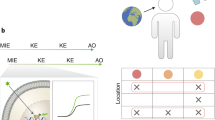Abstract
Maximum cumulative ratio (MCR) is a person's cumulative exposure to multiple chemicals divided by the maximum chemical-specific exposure where exposure is expressed on a toxicologically equivalent basis. It is a tool for assessing the need for performing cumulative exposure assessments. In this paper, MCR values were calculated for the three groups of individuals with biomonitoring data of 26 dioxin-like compounds (DLCs) based on the World Health Organization toxic equivalent factors (TEFs). Although the two occupational groups have higher total toxicity equivalence (TEQ) levels than the NHANES group, average MCR values of the three groups are similar (3.5, 3.6, and 3.2). These MCR values are higher than those seen in our earlier studies, supporting the practice of performing cumulative assessments for DLCs. The MCR values also indicate that only 2–5 of the 26 chemicals make significant contributions to total TEQ values. Interestingly, MCR is negatively correlated with total TEQ (in all the three groups) and age (in the NHANES group). Additionally, MCR is lower in workers where occupational exposures are larger than background exposures. Although overall exposure is the first factor to consider in any mixtures assessment, this paper confirms the usefulness of MCR as a tool for analyzing the pattern of chemical-specific contributions to the total exposure levels of mixtures based on biomonitoring data when TEFs or similar approaches are available.
This is a preview of subscription content, access via your institution
Access options
Subscribe to this journal
Receive 6 print issues and online access
$259.00 per year
only $43.17 per issue
Buy this article
- Purchase on Springer Link
- Instant access to full article PDF
Prices may be subject to local taxes which are calculated during checkout





Similar content being viewed by others
References
NRC. Science and Decisions: Advancing Risk Assessment. Washington, DC, 2009.
NRC. (1994) Science and judgment in risk assessment. Committee on Risk Assessment of Hazardous Air Pollutants, Commission on Life Sciences, NRC. In: Research Management. National Research Council (NRC), Washington, DC.
Callahan M.A., and Sexton K. If cumulative risk assessment is the answer, what is the question? Environ Health Perspect 2007: 115 (5): 799–806.
EPA. Framework for Cumulative Risk Assessment. PA/630/P-02//001A. Washington, DC, 2003.
EPA. Concepts, methods, and data sources for cumulative health risk assessment of multiple chemicals, exposures and effects: A resource document, (EPA/600/R-06/013F). Cincinnati, OH, 2007.
IGHRC. Interdepartmental Group on Health Risks from Chemicals (IGHRC). Chemical mixtures: A framework for assessing risks (Version 6), April 2007. Retrieved September 5, 2011, from http://ieh.cranfield.ac.uk/IGHRC/mixtures_document.pdf, 2007.
Meek M.E., Boobis A.R., Crofton K.M., Heinemeyer G., Van Raaij M., and Vickers C. Risk assessment of combined exposure to multiple chemicals: A WHO/IPCS framework. Regul Toxicol Pharmacol 2011: 60 (2): S1–S14.
Han X.L., and Price P.S. Determining the maximum cumulative ratios for mixtures observed in ground water wells used as drinking water supplies in the United States. Int J Environ Res Public Health 2011: 8 (12): 4729–4745.
Price P.S., and Han X.L. Maximum cumulative Ratio (MCR) as a tool for assessing the value of performing a cumulative risk assessment. Int J Environ Res Public Health 2011: 8 (6): 2212–2225.
OME. (1984). Scientific criteria document for standard development, No. 484. Polychlorinated dibenzo-p-dioxins (PCDDs) and polychlorinated dibenzofurans (PCDFs). Ontario Ministry of Environment, Ontario, Canada.
Van den Berg M., Birnbaum L.S., Denison M., De Vito M., Farland W., and Feeley M., et al. The 2005 World Health Organization reevaluation of human and mammalian toxic equivalency factors for dioxins and dioxin-like compounds. Toxicol Sci 2006: 93 (2): 223–241.
CDC. (2005) Centers for Disease Control and Prevention. NHANES 2003-2004 Laboratory Files. Retrieved September 5, 2010, from http://www.cdc.gov/nchs/nhanes/nhanes2003-2004/lab03_04.htm.
Collins J.J., Bodner K.M., Wilken M., Haidar S., Burns C.J., and Budinsky R.A., et al. Serum concentrations of chlorinated dibenzo-p-dioxins and dibenzofurans among former Michigan trichlorophenol and pentachlorophenol workers. J Expo Sci Environ Epidemiol 2007: 17 (6): 541–548.
Collins J.J., Wilken M., McBride D., Humphry N.F., Herbison P., and Burns C.J., et al. Serum concentrations of chlorinated dibenzo-p-dioxins and dibenzofurans among former New Zealand trichlorophenol workers. Chemosphere 2009: 76 (11): 1550–1556.
Haws L.C., Su S.H., Harris M., DeVito M.J., Walker N.J., and Farland W.H., et al. Development of a refined database of mammalian relative potency estimates for dioxin-like compounds. Toxicol Sci 2006: 89 (1): 4–30.
Hedgeman E., Chen Q.X., Hong B.L., Chang C.W., Olson K., and LaDronka K., et al. The University of Michigan Dioxin Exposure Study: population survey results and serum concentrations for polychlorinated dioxins, furans, and biphenyls. Environ Health Perspect 2009: 117 (5): 811–817.
Hays S.M., and Aylward L.L. Dioxin risks in perspective: past, present, and future. Regul Toxicol Pharmacol 2003: 37 (2): 202–217.
Lorber M. A pharmacokinetic model for estimating exposure of Americans to dioxin-like compounds in the past, present, and future. Sci Total Environ 2002: 288 (1–2): 81–95.
Aylward L.L., and Hays S.M. Temporal trends in human TCDD body burden: decreases over three decades and implications for exposure levels. J Expo Anal Environ Epidemiol 2002: 12 (5): 319–328.
Lorber M., Patterson D., Huwe J., and Kahn H. Evaluation of background exposures of Americans to dioxin-like compounds in the 1990s and the 2000s. Chemosphere 2009: 77 (5): 640–651.
Acknowledgements
We thank Dr. Edward Carney and Dr. Robert Budinsky from The Dow Chemical for their inputs to and review of the work. This work was funded by The Dow Chemical Company, Midland, Michigan, USA.
Author information
Authors and Affiliations
Corresponding author
Ethics declarations
Competing interests
The authors work for The Dow Chemical Company in Midland, Michigan, USA.
Rights and permissions
About this article
Cite this article
Han, X., Price, P. Applying the maximum cumulative ratio methodology to biomonitoring data on dioxin-like compounds in the general public and two occupationally exposed populations. J Expo Sci Environ Epidemiol 23, 343–349 (2013). https://doi.org/10.1038/jes.2012.74
Received:
Accepted:
Published:
Issue Date:
DOI: https://doi.org/10.1038/jes.2012.74



